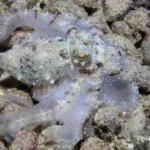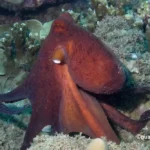The Octopus: A Genius Among the Spineless
Table of Contents
Share This
Octopuses are one of the many unique creatures that inhabit Guam’s waters. Octopuses are solitary animals ranging in size from one gram to an impressive 70 kilograms. They are commonly found in coral reefs where shelter and food are abundant. They have a diverse diet but mostly feed on crabs, clams, and worms. There is a large population all around the island and they are an important food source for many people living on Guam. In 2001 alone, over 3000 pounds of octopus were caught. Scientists do not know how many species of octopus call Guam home. Only 19 have been described but there may be many more.
Biology
Octopuses belong to the Phylum Mollusca and the Class Cephalopoda. Octopuses are invertebrates, meaning that they do not have skeletons. The only hard part on their body is their beak, which is similar to a parrot’s beak. They have three hearts, two of which pump blood to their gills, while the third pumps blood to the rest of their body. Interestingly, their blood is not the red color we are used to, it is blue. Additionally, they do not have what we usually think of as a brain. Rather than being concentrated in one place, most of their nervous system is spread throughout their eight arms. Because of this, their arms are able to move independently and can still move when detached from the rest of their body. Also, the eyes of octopuses are much more complex than the eyes of other invertebrates and can even perceive color.
Defense
Due to their soft bodies, octopuses are a popular food source for many animals. Because of this, octopuses have come up with some unique ways to defend themselves. Their main defense is their ability to hide and camouflage themselves. Since octopuses don’t have bones they are able to fit into very small spaces. They are also masters of disguise, capable of changing their color and texture to blend in with their surroundings (Figure 1). When disturbed, they can release a black ink cloud into the water to act as a screen, allowing them to escape. Octopuses also have a venomous bite, though only the blue-ringed octopus is dangerous to humans. Their venom causes paralysis and within an hour it can stop the heart of a full-grown person. However, this octopus is not found on Guam.
Life cycle
Octopuses live for three to five years before reproducing, and die shortly after. Males, which can be identified by one tentacle that lacks suction cups (called a hectocotylus), will only live for a few months after mating. Several weeks after mating a female octopus retreats to her home, called a den, to lay anywhere from 20,000 to 100,000 eggs. For five to eight months she remains in her den cleaning and protecting her eggs until they hatch. She will not eat while protecting her eggs and will die shortly after the eggs hatch. After hatching, baby octopuses stay in the open water, where they eat plankton. Upon growing big enough to eat larger prey, the octopus will settle to the ocean floor and find a good place to make their den.
Intelligence
Octopuses are very intelligent, which makes them different from other invertebrates. Scientists who study them have shown, by testing them with mazes and problem solving experiments, that octopuses have both short-term and long-term memory. They have been trained to recognize different shapes and patterns and to open jars and boxes using tools. They can also mimic behaviors of other sea creatures. In fact, there is a species called the mimic octopus. This octopus gets its name from its incredible ability to mimic animals such as sea snakes, lionfish, and flounders.
Octopuses can be found all around the world and range in size from minuscule to massive. They have three hearts, venomous saliva, and a parrot-like beak. They can change the color and texture of their skin, squirt ink, and fit into impossibly small spaces. They are more intelligent than many other animals and can solve complex problems and use tools. The octopus is truly an underwater marvel.
About the author

Alisha Gill was a graduate student at the University of Guam Marine Lab. She graduated in 2018. Her thesis was “Egg Predation Rates and Spawning Success among Mating Territories in a Lek-like Mating System of Gomphosus Varius (pisces: labridae).”
Editor’s note: This author was a beginning graduate student in 2017 taking a course in scientific writing at the University of Guam. This article was assigned to provide the student with practice in communicating science to non-scientists. The student chose the topic which is related either to their thesis project or work experience. The instructor in the course is Dr. Laurie Raymundo, a UOG Marine Laboratory faculty member.
For further reading
Hanlon, Roger T., Anya C. Watson, and Alexandra Barbosa. “A ‘Mimic Octopus’ in the Atlantic: Flatfish Mimicry and Camouflage by Macrotritopus defilippi.” The Biological Bulletin 218, no. 1 (2010): 15-24.
Hochner, Binyamin, Tal Shomrat, and Graziano Fiorito. “The Octopus: A Model for a Comparative Analysis of the Evolution of Learning and Memory Mechanisms.” The Biological Bulletin 210, no. 3 (2006): 308-317.
Iglesias, Josè, Juanjo J. Otero, C. Moxica, L. Fuentes, and FJ Sanchez. “The Completed Life Cycle of the Octopus (Octopus vulgaris, Cuvier) under Culture Conditions: Paralarval Rearing using Artemia and Zoeae, and First Data on Juvenile Growth up to 8 Months of Age.” Aquaculture International 12, no. 4 (2004): 481-487.
Norman, Mark D., Julian Finn, and Tom Tregenza. “Dynamic Mimicry in an Indo-Malayan Octopus.” Proceedings of the Royal Society B: Biological Sciences 268, 1478 (2001): 1755-1758.
Ward, Linda A. “The Cephalopods of Guam.” Micronesica 35-36, (2003): 294-302.


